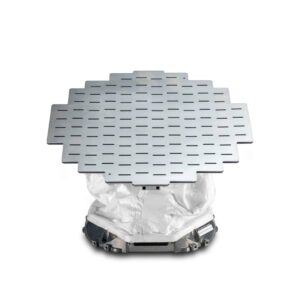Garmin International Inc., a unit of Garmin Ltd. has announced the selection of the GSX 70, a full-featured solid-state weather radar by Northrop Grumman for the U.S. Air Force fleet of RQ-4 Global Hawk unmanned aircraft systems (UAS).
Equipped to fly at a maximum altitude of 60,000 feet with an endurance of 32+ hours, the Global Hawk is a high-altitude, long-endurance UAS. The GSX 70 provides operators with real-time weather information to help analyze convective weather threats and make confident decisions as the mission progresses. The Doppler-enabled weather radar also provides exceptional range and adjustable scanning profiles with precision target definition tailored to the Global Hawk. The GSX 70 will further increase mission effectiveness, safety and reliability, reduce operational costs and expand the overall utility of these aircraft.
“The Global Hawk is an amazing unmanned surveillance aircraft, given the altitude it can attain, its range and incredible endurance, as well as the mission it serves,” said Carl Wolf, vice president of aviation sales and marketing. “The selection of the GSX 70 for the Global Hawk is a testament to the technology and capability of our robust weather radar sensor, providing the United States Air Force with real-time convective weather information that allows pilots to make informed weather-related decisions. We are honored to have been selected to serve Northrup Grumman and the Air Force aboard this versatile, highly capable and valuable asset.”
Increased Mission Effectiveness
The all-digital GSX 70 offers improvements to support increased capability and reliability of the Global Hawk fleet throughout their worldwide missions. The Global Hawk is a high-altitude and long-endurance unmanned aircraft system, which increases the likelihood adverse weather is encountered along the route of flight. The GSX 70 offers horizontal scan angles of up to 120 degrees to provide increased visibility into the strength and intensity of convective activity. Vertical scanning mode aids operators in analyzing storm tops, gradients and cell buildup activity at various altitudes. Utilizing the GSX 70, operators can make sound weather-related decisions using real-time weather products, greatly aiding in increased mission effectiveness for these aircraft.
Advanced Weather Features
Global Hawk operators will have the opportunity to more confidently navigate around challenging weather with the GSX 70. The GSX 70 provides unique benefits that further enhance the weather display such as Turbulence Detection, which identifies turbulence in air containing precipitation and other airborne particulates. Ground Clutter Suppression separates ground returns and removes them from the display, so operators can focus on weather of interest. These benefits will help operators easily identify developing areas of adverse weather by providing an extra barrier of safety throughout their operations.
Integrated with Ease
Additional equipment expense is eliminated and installation time is reduced when incorporating the GSX 70, allowing for a streamlined and economical installation path. Weight and associated installation costs are minimized as the GSX 70 interfaces via Ethernet to a modem already installed in the U.S. Air Force fleet of RQ-4 Global Hawk aircraft. On the ground, weather is displayed on existing mission displays in the Global Hawk ground control stations, saving space and eliminating the expense associated with incorporating new equipment.
GSX 70 Reliability
The GSX 70 compact, all-in-one antenna, receiver and transmitter, is designed for installation in a wide variety of applications. Several antenna sizes are available, ranging from 10 to 18-inches. The GSX 70 is a complete, all-inclusive weather radar senor solution that eliminates the need to incorporate multiple platforms, reducing long-term cost of ownership. Built to withstand harsh environmental conditions, the GSX 70 boasts a rugged design that is tolerant of severe temperatures found at higher altitudes. Advanced features such as Doppler-enabled Turbulence Detection and Ground Clutter Suppression allow for easier, more precise weather interpretation. Pilot workload is reduced with Altitude Compensated Tilt, which doesn’t require pilot input or tilt adjustment with an increase or decrease in aircraft altitude. Additionally, features such as WATCH™ (Weather Attenuated Color Highlight) helps to identify shadowing effects of short-range cell activity, highlighting areas where radar signals are weakened or attenuated by intense precipitation returns. Among the lightest weather radar in the industry, the 9.5 lbs. (4.3 kg.) GSX 70 provides additional savings in weight compared to other weather radar systems on the market.
The installation of the GSX 70 weather radar, which will include Turbulence Detection and Ground Clutter Suppression, within the U.S. Air Force fleet of RQ-4 Global Hawk UAS is expected to begin in Q1 2016.



















